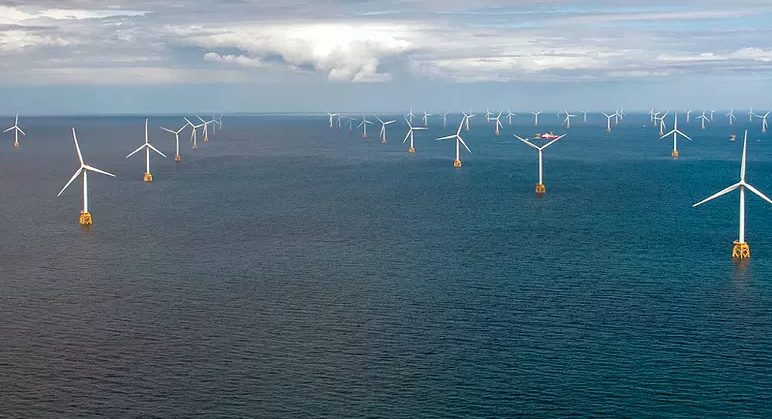Renewable energy comes from natural sources or processes that are constantly replaced (consider wind and sunlight, for instance: they will always keep blowing and shining, even if their availability is subject to time and weather). While renewable energy is often treated as if it’s a relatively modern concept, the harnessing of nature’s power has in fact long been used for transportation, heating, lighting, and much more.
And while, nowadays, fossil fuels are also relied upon, humans are nevertheless discovering more modern and low-cost ways to capture and retain solar and wind energy. Renewable energy resources are altogether becoming increasingly vital as a source of electrical power.

Eco-friendly energy storage has been adopted to the point that even some households can help to safely generate electricity. Pictured: an aerial view of rooftop solar panels on a suburban house
Image credit: Bigstock
The expansion of these renewable sources is also happening at both large and small scales, ranging from rooftop solar panels that can sell power back to the grid all the way up to mega wind farms. As the use of renewables continues to grow, Scotland has taken a huge role in utilising these sources to produce clean electricity to meet the country’s daily power demands. Following the news that mid-2020 saw the UK achieve 67 days without burning coal for electrical energy, as well as Scotland’s own plans to go fully electric, let’s now discuss the country’s current efforts on, and potential for, renewable energy generation.
Scotland’s Renewable Energy
To quote Prime Minister Boris Johnson, “As Saudi Arabia is to oil, the UK is to wind”. Indeed, the UK—but more specifically, Scotland—is not only a place of vast resources, but also the windiest part of Europe.
Johnson continues: “We've got huge, huge gusts of wind going around the north of our country: Scotland. [There is] quite extraordinary potential we have for wind”.
In 2019, when its renewable enetgy output was 90.1%, the Scottish government set a target of achieving 100% of its electricity demand from renewable energy sources by the end of 2020—and it ended up coming very close at 97.4%. This is particularly promising when you consider that, according to the BBC, back in 2009, only 27.2% of Scotland’s total electricity was generated by using renewable energy sources, while, again, it was over 90% in 2019. Indeed, 2019 was a record year for renewable electricity production in Scotland—with 30.5 terawatt-hours having been produced by the country.
According to the Scottish government’s reporting (published on Scottish Energy Statistics Hub), this much energy is sufficient to power all households in Scotland for over three years, or charge almost 6.7 billion mobile phones for a year. Scotland generated 25.3% of the UK’s total renewable electricity generation in 2019.

Some of the wind turbines of the Beatrice Offshore Windfarm Ltd project
Image credit: Beatrice Offshore Windfarm Ltd.
About the Beatrice Wind Farm
Scotland produces clean electricity by capitalising on offshore and onshore wind energy, hydro energy, solar energy, and biomass. While Scotland’s onshore wind delivers about 70% of the country’s capacity, Scotland’s largest single source of renewable energy is the Beatrice Offshore Wind Farm, although it was renamed the Beatrice Offshore Windfarm Ltd (BOWL) project. According to the wind farm’s official webpage, the wind farm has 84 turbines, each of which are 53 metres taller than the London Eye.
It first went into operation in 2019. The BOWL project alone is capable of generating enough power for 450,000 homes. On top of this, another Scottish wind farm project, the currently-under-construction Seagreen Farm, will be even bigger and able to provide 1.3 million homes with low-carbon energy, according to its website.
Global Increase in Renewables
According to BP (British Petroleum), by 2040, if current trends in renewable technology innovation continue in such a fast-growing rate, then renewable energy production will grow by 400% globally of their current amount. But this will nevertheless only be enough to cover 14% of the world’s total global energy demand. This expansion in renewable energy will be led by China, followed by other developing countries. BP links this potential, sizeable growth in renewable technology reliance to the current, downward trend in the cost of wind and solar energy equipment installation.
In view of the general increase in human-made climate change, it has now become all the more vital to reduce carbon emissions, and Scotland’s innovative engineering efforts are a clear reflection of a country that is acting accordingly.
For more information on Europe’s engineering efforts in renewable innovation, search ‘renewables’ on Electronics Point: you’ll find articles on a floating hybrid energy platform, an overview of the UK’s ‘net zero’ efforts, and more.





